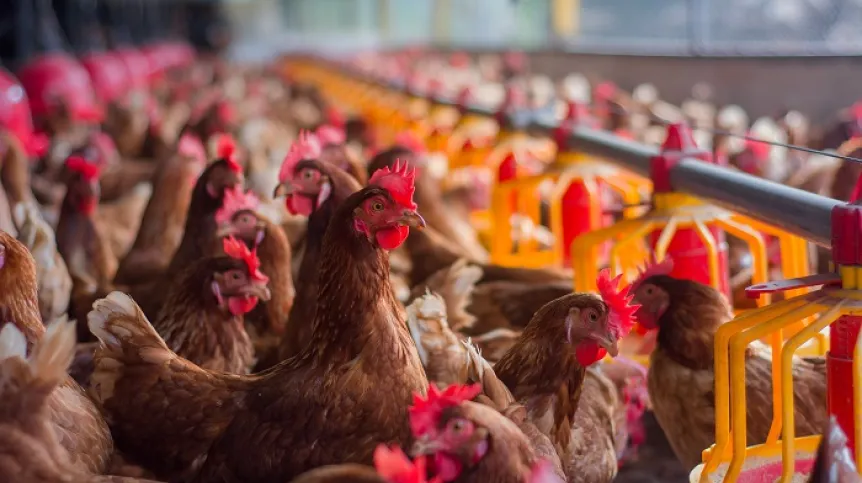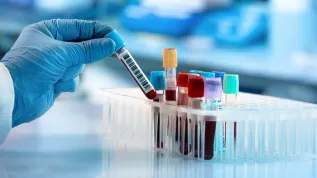
Broad-spectrum antibiotics are present in the soil near the poultry farm, found scientists from the University of Warmia and Mazury in Olsztyn. Drugs were also detected in groundwater, and antibiotics in drinking water. The phosphorus content was two and a half times higher than the average for soils in Poland.
[THIS ARTICLE HAS BEEN UPDATED WITH THE POSITION OF THE POLISH MEAT ASSOCIATION - INFORMATION AVAILABLE AT THE BOTTOM OF THE TEXT]
Scientists from the University of Warmia and Mazury investigated how a poultry farm affects the environment. They analysed two aspects - the soil and hydrogeological wells with observation holes used to assess the degree of groundwater contamination, called piezometers. For the study, they collected water from piezometers from a level of 25 to 45 m.
'We detected seven drugs in groundwater collected at a depth of 35 m', says Professor Agnieszka Piotrowicz-Cieślak from the Department of Plant Physiology, Genetics and Biotechnology at the Faculty of Biology and Biotechnology of the University of Warmia and Mazury, quoted in an interview posted on the University of Warmia and Mazury website.
In addition to these wells, scientists also tested tap (drinking) water. 'We analysed three local sources and found antibiotics in each of them,’ emphasises Piotrowicz-Cieślak.
According to the researcher, residents of the surrounding areas use such tap water. 'Consumption of water contaminated with antibiotics causes antibiotics to enter human and animal bodies. Even such small concentrations of drugs in food and water, which do not have a clear therapeutic effect, may be harmful, especially to children,’ she says.
She adds that 'not everyone realizes that poultry production affects the environment to a much greater extent than the production of other types of food'. Farms emit pollutants to all components of the environment: air, soil, surface water and groundwater, thus affecting humans, animals and plants.
‘The most common pollutants emitted by poultry farms include drugs and phosphates. Although the latter compounds belong to plant nutrients and are not considered toxic, their high concentrations cause environmental problems - water fertilization and excessive growth of algae.’
Scientists from the University of Warmia and Mazury found phosphorus content in the soil near the poultry farm that was two and a half times higher than the average for soil in Poland. 'Excessive amounts of phosphates in the soil limit the uptake of iron and zinc by plants, which causes symptoms of deficiency of these elements,’ says Piotrowicz-Cieślak. She adds that 'zinc deficiency in plants results in deficiency in humans, because plants are the main source of this element for humans'.
The largest group of organic pollutants emitted by intensive poultry farming in Poland are pharmaceuticals. 'Although the use of antibiotics is subject to legal regulations, the scale of their consumption is not fully known. Consumption reports are based on the sales values obtained from pharmaceutical companies,’ says Piotrowicz-Cieślak.
In the soil, scientists detected the presence of substances including enrofloxacin, ciprofloxacin and trimpetoprim - broad-spectrum antibiotics. 'Antibiotics occurring in the environment, even in low concentrations, contribute to the spread of antibiotic resistance, thus affecting human health. Even in low concentrations, they can affect the composition of the soil and plant microbiome,’ he adds.
In addition to antibiotics, the researchers detected residues of metoclopramide and carbamazepine in the soil.
'Metoclopramide is an antiemetic agent that improves intestinal peristalsis. Carbamazepine is an anxiolytic and sedative; it permanently pollutes the environment because it is resistant to degradation,’ says Piotrowicz-Cieślak. She adds that 'the presence of carbamazapine in the vicinity of intensive poultry farms has not been detected anywhere in the world so far'.
The scientists also detected pesticide and herbicide residues in the tested soils.
'If manure after antibiotic treatment is used on a poultry farm, the flowing rainwater washes the drugs into groundwater, which is anaerobic, and the drugs do not decompose. Therefore, we find much more of them in groundwater than in the soil itself,’ says Piotrowicz–Cieślak.
The research carried out as part of the project concerned a small farm with only five hen houses, with over 5,000 chickens are kept there. 'It is very difficult to convince farm owners to cooperate with scientists studying environmental pollution, because only the producers who believe that they is acting in a manner that does not raise any objections will let us in', emphasises the scientist from the University of Warmia and Mazury.
The research was conducted as part of the OPUS 18 project 'Intensive poultry farming - identification of changes taking place in the natural environment and their impact on human health', financed by the Polish National Science Centre. Its leader is the Medical University of Gdańsk, which researches the impact of farms on human health. The completion of the project is planned for July 2024.
'We are currently finishing chromatographic analyses,’ says Professor Lidia Wolska, the project leader and head of the Department of Environmental Toxicology at the Medical University of Gdańsk. Then, scientists will analyse the results, study correlations, explain the phenomena, take into account the hydrogeological conditions and finally prepare publications on the topic.
Poultry meat is one of the key types of food of animal origin consumed all over the world. Poland is the largest poultry producer in Europe.
As the authors of the project emphasise: 'in the last decade in Poland we have observed a rapid increase in the number of intensive breeding farms, including chicken farms. In this process, conditions are created for a rapid increase in the body weight of chickens in a 6-week cycle (selected meat breed, 24-hour access to food and water, continuous lighting in the initial period, administration of vaccines and other drugs, including antibiotics, and removal of excrements only after the end of the production cycle).’
The scientists note that 'many unfavourable phenomena are observed during chicken breeding, such as: high concentrations of toxic substances (including ammonia) in the internal air of the hen house, as well as high concentrations of bioaerosol, which negatively affects the welfare of animals and probably affects the health of employees; emission of bioaerosol and odours into the outdoor air and the probable impact of these pollutants on the state of the environment and the health of people living in the vicinity of farms; transpoting faeces contaminated with drugs to agricultural fields, which causes contamination of soil and groundwater.
Few reports indicate that the pollutants emitted from intensive breeding farms have an impact on health, in particular by negatively affecting the respiratory system of employees and people living in the vicinity of farms.
'To clarify, current research indicates that there is no observed impact of farms on healthy people, of course within a specific range of concentrations of harmful agents and a specific duration of exposure,’ says Professor Lidia Wolska. 'However, an exacerbation of disease states has been observed in people already suffering from respiratory diseases,’ she adds.
As part of the project, scientists are looking for answers to the question of the chemical and microbiological composition of the aerosol generated during intensive breeding of chickens; the scope and effects of its impact on the health of employees and people living around farms, including the quality of life; how soil properties and their quality change in the area affected by intensive poultry farming (presence of chemical pollutants, changes in soil biological activity, changes in the composition of the microbiome, ecotoxicity, drug resistance) and whether drugs (antibiotics) get from soil fertilized with faeces into water and plants crops and what risks they pose to the health of consumers.
Full research results are expected to be available within a year. The project involves a scientific team composed of specialists from four scientific and research centres: the Medical University of Gdańsk, the Central Institute for Labour Protection - National Research Institute, the Institute of Soil Science and Plant Cultivation, the University of Warmia and Mazury in Olsztyn.
[UPDATE WITH THE POSITION OF THE POLISH MEAT ASSOCIATION]
In response to the above publication regarding a research project, the Polish Meat Association provided PAP - Science in Poland with a position in which it was emphasized that 'in order to evaluate the entire sector, conclusions should not be drawn from the results of a single study from one place.’
'A single analysis based on samples taken from an unidentified reservoir should not be treated as a reliable and objective scientific study. It is scandalous to formulate claims and allegations based on the incidental result of testing one small farm and treat it as representative of the entire poultry sector in Poland,’ the scientists said.
They added: ’As an EU member state, Poland strictly follows EU regulations. Several institutions supervise the correctness of procedures and food quality, including the Chief Veterinary Inspectorate, the State Sanitary Inspection and the State Plant Health and Seed Inspection Service (PIORIN). Responsibility for research in this area lies with authorized and reference laboratories.’
Each of these organizations has designated areas of competence, within which it supervises chemical substances used both in animal breeding and food production. The effectiveness of these activities is confirmed by the results. Despite meticulous and regular inspections, no large-scale drug mishandling was detected, which could indicate mass pathology. However, there are incidental cases to which the relevant services respond quickly and effectively. It is worth noting that the poultry industry also actively responds to any irregularities, striving for full transparency of research. It is in its interest to maintain high standards of food quality and safety.
The entire poultry sector is open to reliable scientific research - it is essential for the functioning of the meat industry. However, research should be conducted in accordance with applicable law - the guidelines of Regulation (EU) 2018/782 specifying the methodological principles of risk assessment and recommendations related to risk management, consistent with the principles of the European Medicines Agency regarding maximum residue limits of pharmacologically active substances permitted in food of animal origin,’ the scientists say.
The full text of the position is available on THIS website.
PAP - Science in Poland
amk/ zan/ kap/
tr. RL













